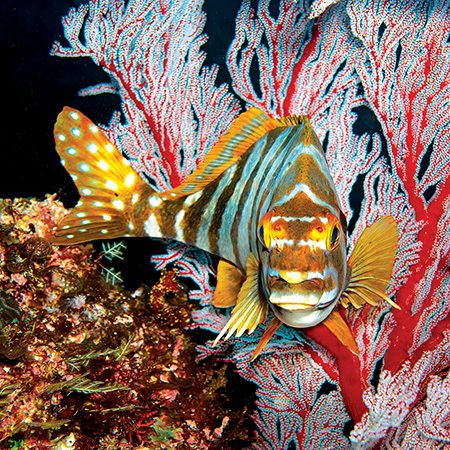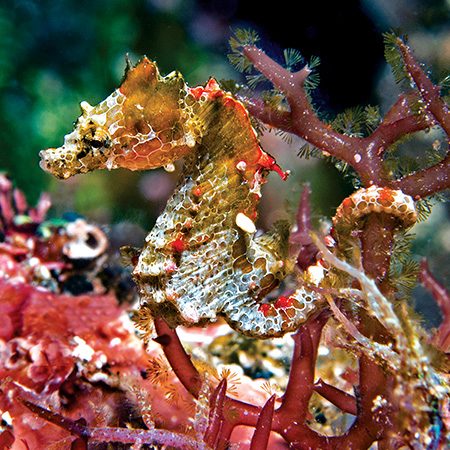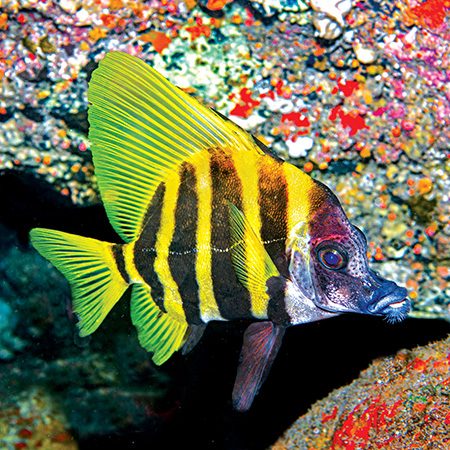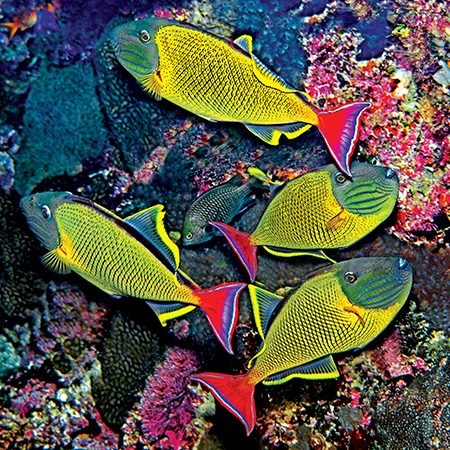Diving is a moveable feast. Japan’s southern chains of semitropical volcanic islands prove this point well.
On our first trip to Hachijō-jima in 2015, we were in the company of friends on a mission to photograph a scientifically undocumented pygmy seahorse the size of a pumpkin seed. Even after a concerted four-day search, the tiny target eluded our efforts until a single seahorse miraculously materialized in the last minutes of the last dive on the last day.
Our multiday hunt ultimately delivered a splendid trophy but left us with little time to investigate the many other unfamiliar fish faces peering out from the island’s famed underwater caverns and archways that centuries of lava flows have sculpted. The four of us returned to Hachijō-jima in May 2023 to see what we missed the first time.
We harbored a real concern about safely getting in and out of the water. In Hachijō, like many dive destinations in Japan, entries are not always as easy as stepping off the back of a boat. Although boats are available, recreational divers traditionally access much of the country’s most dramatic underwater terrain from rugged shorelines, where streams of lava once poured into the sea. Besides creating cavernous wonderlands for divers to explore, the lava left behind vast networks of labyrinthine hideaways — habitat as indispensable for the survival of Japan’s inshore fishes as coral reefs are in tropical waters.


Long before scuba, generations of Japanese seafarers took advantage of the lava-cut pathways to the sea to launch their boats. Breakwaters, seawalls, and harbors were later added to temper the force of the seas. By fate and good fortune, the centuries of resourceful engineering to benefit fishers have also made shore diving in the unruly waters feasible during much of the year — but it didn’t always make it easy.
Nazumado is one of our favorite shore dives on Hachijō and at times is one of the most daunting. During calm seas, it’s a cup of tea. On marginal days, which are frequent, divers need a thick rope to negotiate the long, slippery slope that regularly becomes submerged in a surging sea during high tides.
Local divers, used to their home waters’ dicey conditions, make short work of the matter: Fully outfitted in fins, wetsuits, tanks, weights, and cameras, teams walk down the rope backward, fist over fist, one after the other, often with rollers crashing above their knees. Reaching the drop-off, each diver in turn plunges into the sea like a trained seal, pops to the surface, flips onto their back, and kicks with purpose to escape the wave-washed wall.
Not these old bones. Instead, Anna and I clutch the rope gingerly, work our way down the incline with fins in hand, and tumble into the churning water. Our host, Kotaro, was bobbing just beyond the breakers with our inflated BCDs and cameras.


Below the surface, conditions are a dream as we glide into a shadowy maze of light-streaked passageways, fissures and chasms sliced through with ledges and undercuts jam-packed with adventure, and assorted fishes of various colors and sizes — some new and others well-known friends from tropical waters.
The first unfamiliar shapes to catch our eyes were the physically impressive boarfishes and morwongs. These subtropical, nocturnal foragers were lazily hovering like blimps in the half-light of their secure daytime retreat.
Within minutes a courting pair of 2-inch blennies stop us in our tracks. Although new to us, we instantly recognize the species from photos showcasing the males’ outrageous courtship colors. Rather than laying their fat-filled eggs inside the safety of holes like most of their lineage, these Japanese island blennies (Helcogramma nesion) spawn in the open.
Luckily for us, this pair settled on top of a rock where we had a bird’s-eye view of the extended affair. Each time the female laid a fresh string of eggs across a bed of algae, her suitor, dancing and prancing inches away, would swoop to her side, flaunt his flamboyant call-to-action colors, and, in a fleeting moment of bliss, fulfill his definitive task in life.
In the sunlight outside the caverns, surgeon, angel, and butterflyfishes paraded their beauty along the heavily encrusted walls and archways. But much like on our previous Hachijō trip, we once again spent an inordinate amount time prowling through endless stretches of algae- and sponge-cloaked lava rocks. It is what we love to do: Search where eyes seldom wander for rarely seen animals hiding like ghosts among tangles and crevices.
The hunting was good. Among our bounty of cryptic blennies, gobies, and clingfishes, we also chanced upon a big bonus — not one, but five of our prized pygmy seahorses, scientifically described in 2018 as Hippocampus japapigu. Their name means “Japan pig” — an affectionate nickname that fish-doting Japanese divers bestowed upon their beloved native seahorse decades ago.
© Alert Diver — Q1 2024